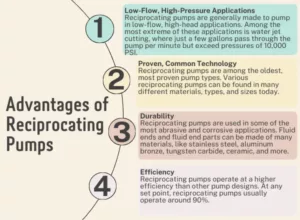
Reciprocating Pumps and Applications: What Are the Basic Components of a Reciprocating Pump?
A reciprocating pump works as a positive displacement pump where a specific volume of liquid is collected in an enclosed volume and discharged to the required application using pressure. Reciprocating pumps are more fitting for low volumes of flow at high pressures.
So, what is a reciprocating pump and what are the basic components of a reciprocating pump?
Reciprocating Pumps and Common Applications
Reciprocating positive displacement pumps are highly effective, where a high degree of accuracy and reliability under different ranges of conditions are required. Reciprocating pumps with high efficiency are often available in various hydraulic, mechanical, and material options. They are widely used across chemical, petrochemical, refinery, pharmaceutical, cosmetic, and water treatment industries.
Typically, these types of pumps are used for applications such as Salt Water Disposal, Well Services, Descaling, Hydraulic Fracturing, and Oil & Gas Pipelines. All reciprocating pumps are easily available in the market to meet the diverse demands of different processes and applications. Piston pumps are widely used in Energy Recovery, Steam Recovery, and hazardous area pumping applications.
How a Reciprocating Pump Works
To help visualize how a reciprocating pump operates, let’s look at a single piston and split the process into four parts.
Action 1: The plunger or piston is pulled back. The action increases the volume of the cavity. As the cavity volume expands, fluid is drawn in through the inlet to fill the expanding cavity.
Action 2: The piston has reached its maximum displacement. Since it is not moving into or out of the cavity, fluid is not flowing through the inlet or the outlet.
Action 3: It is pushed back into the cavity after reaching its maximum position. During this process, the piston applies enough pressure to the fluid to overcome the pressure in the pump outlet. This pressure differential pushes the fluid inside the cavity through the pump outlet.
Action 4: The piston reaches its maximum extension into the cavity. Here, the volume of the cavity is at a minimum, and fluid is not flowing through the inlet or the outlet. The next action repeats the process, starting again with action 1.
What Are the Basic Components of a Reciprocating Pump?
Suction Pipe
A suction pipe connects the liquid source to the reciprocating pump’s cylinder. The liquid is sucked by this pipe from the source to the cylinder.
Suction Valve
This valve, known as a suction valve, ensures flow in just one direction, making it a non-return valve for specific use. This is put between the suction pipe inlet and cylinder. During liquid suction, it is opened, and during discharge, it is closed.
Delivery Pipe
The delivery pipe connects the cylinder of the pump to the outlet source. The liquid is delivered to the desired outlet location through this pipe.
Delivery Valve
The delivery valve, a non-return valve, is placed between the delivery pipe outlet and the cylinder. It is in a closed position during suction and an open position during liquid discharging.
Cylinder
A hollow cylinder made of cast iron steel alloy. The piston and piston rod’s arrangement is inside this cylinder. Suction and release of liquid take place in this, so both delivery pipes and suction, along with valves, are connected to this cylinder.
Piston, Plunger, or a Diaphragm
All these components have the basic functionality of moving the liquid inside the cylinder. The piston is a lubricated sliding shaft that moves inside the cylinder and pushes the liquid forward and backward, creating a cavity and high pressure at the outlet.
A diaphragm pump avoids leaking the liquid since it prevents it from penetrating outside. Hence, it is especially useful when the liquids are dangerous or toxic. A plunger pump has a stationary high-pressure seal and a smooth cylindrical plunger slides through this seal.
Piston Rod
The piston is a solid type cylinder that moves forward and backward within the hollow cylinder to perform suction and deliverance of liquid. The piston rod helps the piston move in its linear motion.
Crank and Connecting Rod
A crank is a solid circular disc connected to a power source, such as an engine, motor, etc., for its rotation. The connecting rod attaches the crank to the piston. Due to that, the rotational motion of the crank gets turned into the linear motion of the piston.
Strainer
A filter is provided at the end of the suction pipe to stop the entrance of solids from the water source into the cylinder.
Air Vessel
Air vessels are attached to both suction and delivery pipes to remove the frictional head and give a uniform discharge rate.
Advantages of Reciprocating Pumps
Low-Flow, High-Pressure Applications
Reciprocating pumps are generally made to pump in low-flow, high-head applications. Among the most extreme of these applications is water jet cutting, where just a few gallons pass through the pump per minute but exceed pressures of 10,000 PSI.
Proven, Common Technology
Reciprocating pumps are among the oldest, most proven pump types. Various reciprocating pumps can be found in many different materials, types, and sizes today. Reciprocating pumps range from less than one horsepower to over 3,000 horsepower.
Durability
Reciprocating pumps are used in some of the most abrasive and corrosive applications. Fluid ends and fluid end parts can be made of many materials, like stainless steel, aluminum bronze, tungsten carbide, ceramic, and more. Many valve types are used in abrasive applications such as pumping cement, sand slurry, mud, etc.
Efficiency
Reciprocating pumps operate at a higher efficiency than other pump designs. At any set point, reciprocating pumps usually operate around 90%.
Factors That Determine the Efficiency Of A Reciprocating Pump
Several performance indicators of a reciprocating pump determine how effectively it works. Following are some of the key performance indicators:
- Brake Horsepower (BHP): How much is the actual power requirement at the input shaft to achieve the desired pressure and flow?
- Capacity: It can be identified as the total volume of liquid/flow delivered per unit of time.
- Slips: Slip is the capacity loss as a fraction or percentage of the suction capacity.
- Mechanical efficiency: It works at full load pressure, and speed is 90% to 95%, depending on the size, speed, and construction.
- Pressure: Mainly, the suction and the discharge pressure in a pump.
- Displacement: Also known as GPM, it is the calculated capacity of the pump with no slip losses.
Reciprocating Pump Variations
Plunger pumps come in a variety of styles, shapes, and sizes. The specific type of pump chosen for an application considers the pressures encountered, the flow rates required, measurement and control systems, fluid corrosivity and viscosity, pipe material, etc.
Careful attention must be given to the application before choosing a pump. Selecting the wrong pump for a job can damage equipment, piping, and systems and possibly endanger personnel.
Types of Reciprocating Pumps
The following are commonly known types of reciprocating pumps:
- Single-acting reciprocating pump: This has one discharge valve and one suction valve. Once the piston is moved backward, suction occurs, and once it moves forward, the delivery valve opens up to discharge the liquid.
- Double-acting reciprocating pump: Unlike single-acting pumps, there are two suction and delivery valves. With each stroke, suction and expulsion happen simultaneously when the piston is moved forward or backward. Thus, it needs two inflow pipes and two outflow pipes. Some common applications of these pumps are in Salt Water Disposal, Well Service, Descaling, Hydraulic Fracturing, and Oil & Gas Pipelines.
- Acting — Air and Steam pumps are double-acting pumps where steam, air, or gas transmit power to the liquid via the piston. The ratio of total steam force (equal to steam pressure per unit area x the steam piston’s area) to total liquid force (equal to pump head x the liquid piston’s area) helps determine the efficiency with which the pump creates pressure. They can operate at any pressure point and flow within a flexible range.Due to these features, steam-driven pumps are mostly used in the refineries for pump-out service, with low NPSH, and the fluids used are hydrocarbons, mostly with high viscosity and high temperature. National, Gardner Denver, Oilwell, Gaso, and Wheatley are known as key manufacturers of such pumps.
- Simplex, Duplex, Triplex, Quintuplex Pumps: Simplex (one), duplex (two), or triplex (three) cylinders are known as reciprocating type pumps. Duplex pumps are usually used where the two pumps can be used alternatively. Such pumps are mostly used in oil-line pumping, mine de-watering, and chemical and petroleum product transfer, but they have many more applications.A triplex pump consists of three plungers to lessen the pulsation of a single reciprocating pump. Quintuplex pumps are designed with a gear case that assists in a high-pressure task. Common applications include cement slurries, sand-laden fluids, crude oil, acids, mud, and other well-servicing fluids.
- Metering Pumps: A metering pump is usually used where the liquid’s flow rate must be adjusted in a specific period. Most metering pumps are piston-driven and are called Piston pumps. Piston pumps can maintain a steady flow rate despite varying discharge pressures. Piston and plunger pumps belong to the category of reciprocating positive displacement pumps. They employ a plunger or piston to propel fluid or substance through a cylindrical chamber.
Reciprocating Pumps can also be classified according to the number of cylinders: Single cylinder and double-cylinder pumps. They are also sometimes classified according to their operation, known as simple hand-operated reciprocating pumps & power-operated deep well reciprocating pumps.



